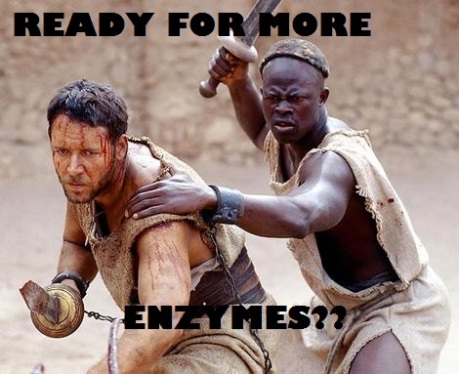IMAGE 79
M-M Equation
Leoner Michaelis and Maude Menten proposed a model that shows that an enzyme can increase the kinetic rate of a reaction and also showed that the rate of a reaction depends on the concentration of the enzyme and the substrate.

IMAGE 80
The M-M equation demonstrates how the velocity of a reaction varies with the concentration of the substrate.

IMAGE 81
Assumption in Deriving the M-M Equation.
Steady State assumption- the enzyme- substrate concentration is constant since the rate of its formation is equal to its rate of degradation.
Relative Concentration of Enzyme and Substrate- the concentration of the substrate is larger than the concentration of the enzyme.
Initial Velocity- measures the rate of the reaction as soon as the enzyme and substrate are mixed. At that point the concentration of the product is very small so the back reaction is neglected.
Conclusions of M-M Equation
1) Characteristic of Km
Km is a feature of an enzyme and its substrate. Km numerically is equivalent to the concentration of the substrate at which the velocity of the reaction is equivalent to 1/2Vmax. Km does not change with the concentration of the enzyme.
Small Km – Gives a high affinity of the enzyme for substrate.
Large Km – Gives a low affinity of the enzyme for the substrate.
2) Order of the Reaction
The velocity of the reaction is proportional to the concentration of the substrate when the concentration of the substrate is less than the Km. the reaction is 1st order with respect to the concentration of the substrate.
The velocity of the reaction is constant and equal to the Vmax when the concentration of the substrate is greater than the Km. The reaction is independent of the substrate concentration and therefore a zero order reaction with respect to the substrate concentration.
Lineweaver – Burk Plot

IMAGE 82
The hyperbola curve of the M-M equation is transformed into a straight line. The straight line is obtained by taking the reciprocal of each term in the M-M equation. The Lineweaver –Burke Plot can be used to obtain Km , Vmax and the mechanism of the enzyme inhibitors.
Inhibitors
Any substance that stops an enzyme catalysed reaction. There are irreversible inhibitors and reversible inhibitors.
Irreversible Inhibitors forms covalent bonds with enzymes. Once the enzyme is inhibited it cannot be reversed.
Reversible Inhibitors forms non-covalent bonds with enzymes. When the enzyme is inhibited the process can be reversed.
Types of Reversible Inhibitors
Competitive
Non- competitive
Uncompetitive
Mixed inhibition
Competitive Inhibitors

IIMAGE 83
Bind to the same site as the substrate. The inhibitor has a similar shape as the substrate.
Non- competitive Inhibitors

IMAGE 84
Binds to a different site on the enzyme. This can bind to the enzyme or the enzyme substrate.
Uncompetitive Inhibitors

IMAGE 85
Binds at a different site only on the enzyme substrate.
Mixed inhibition

IMAGE 86
Binds on separate sites of either the enzyme or enzyme substrate while decreasing the affinity of the enzyme for substrate.

IMAGE 87
Table Showing how the different Inhibitors Affect Km and Vmax
| Reversible Inhibitor | Km | Vmax |
| Competitive | Increases | Constant |
| Non-competitive | Constant | Decreases |
| Uncompetitive | Decreases | Decreases |
| Mixed | Can increase or decrease | Decreases |
Allosteric Enzymes
Allosteric enzymes have more than one binding site. Effectors which are modifiers regulate these enzymes. Effectors bind non-covalently to another binding site of the allosteric enzyme. Effectors can change the affinity of the enzyme for substrate or can change the enzyme’s maximal catalytic activity. Effectors that inhibit the enzyme are negative effectors while effectors that increases the affinity of the enzyme are positive effectors.
Homotrophic and Heterotrophic Effectors
Homotrophic effectors are substrates that act as an effector while a heterotrophic effector is an effector other than a substrate
IMAGE 88
References for Images:
https://biochem1362blog.wordpress.com/wp-content/uploads/2014/02/gladiator.jpg
http://biochemistry.wur.nl/CellCycle/CCMMKinetics.html
http://www.namrata.co/category/semester-paper/
http://course1.winona.edu/sberg/308s09/Lec-note/EnzymesB.htm
http://www.elmhurst.edu/~chm/vchembook/573inhibit.html
http://click4biology.info/c4b/7/pro7.6.htm
http://en.wikibooks.org/wiki/Structural_Biochemistry/Enzyme/Uncompetitive_Inhibitor
http://csrri.iit.edu/~howard/biochem/lectures/enzymeinhibition.html
http://www.biology.arizona.edu/biochemistry/problem_sets/energy_enzymes_catalysis/03t.html
